The Gel-State Electrolytes in Zinc-Ion Batteries
Abstract
1. Introduction
2. Working Principle and Mechanism of Gel-Electrolyte-Based ZIBs
3. Gel-State Electrolytes
3.1. Hydrogel Electrolytes
3.2. Self-Healing Gel Electrolytes
3.3. Gel Polymer Electrolytes
3.4. Thermoreversible Gel Electrolytes
3.5. Additional Functions of Gel-State Electrolytes
3.5.1. Antifreeze Gel Electrolytes
3.5.2. Self-Protected Gel Electrolytes
- Compared with water solutions, the ionic conductivity of gel-sate electrolyte is insufficient, which is mainly due to the easy crystallization of gel electrolytes at room temperature. For example, PEO is a semi-crystalline polymer at room temperature, and its segmental kinetics in the crystalline region are weak, resulting in poor ionic conductivity (10−8 ~ 10−5 s/cm) and small ion mobility numbers;
- The thermal stability and electrochemical stability need to be further improved. GPE with poor thermal stability will affect the safety of ZIBs, to a certain extent. For example, water in the electrolyte vaporizes at high temperatures, increasing the pressure inside the battery. On the other hand, GPE will absorb more water in an aqueous environment, leading to poor electrochemical performance of the batteries;
- Mechanical stability of gel-state electrolyte needs to be further improved. Although single-component polymer electrolytes can exhibit high ionic conductivity, the mechanical strength still needs to be enhanced. Multicomponent gel electrolytes are expected to solve the durability challenges, for which the formation of composite structures or hierarchical structures by chemical bonds or the combination of polymer networks and gel electrolytes provides a good basis for improving mechanical stability;
- For high-performance ZIB construction, especially for flexible batteries, it is necessary to enhance the durability of the Zn metal anode, such as strengthening the mechanism of stabilizing the anode and improving the performance of electrode materials;
- The wider electrochemical potential window of gel-state electrolytes should be developed to adapt the using for high-voltage aqueous flexible batteries;
- The interface problem between electrode and electrolyte needs to be optimized. This is mainly because the gel electrolyte is in solid–solid interface contact. Although there is liquid solution in the network of the polymer matrix, the liquid content is relatively small, and the contact is not as good as for a liquid solution;
- Although the current ZIBs based on gel electrolytes have various breakthroughs in some respects, the development and design of multifunctional gel electrolytes are still challenging.
| Electrolyte | Condition | Function | Reference |
|---|---|---|---|
| PVA + methanesulfonic acid | Current density (A g−1)/cycles | Capacity retention | [43] |
| 2/500 | 92.7% | ||
| -/2000 | 88.1% | ||
| PDHE | Temperature (°C)/cycles | Capacity retention | [44] |
| −10/1000 | 96% | ||
| Guar gum/ZnSO4/glycerol | Current density (A g−1)/cycles | Capacity retention/Capacity (mAh g−1) | [45] |
| 10/10,000 | 98.5%/- | ||
| 1/5000 | -/200 | ||
| PVA-Zn/Mn | Bending/current density (A g−1)/cycles | Capacity (mAh g−1) | [47] |
| 60/-/30 90/-/30 180/-/30 -/200/40 | 110 121 106 123 | ||
| CMC/ZnSs | condition | State | [49] |
| 0.5–10 mA cm−2 | Plating/stripping stability | ||
| Overpotential:45–175 mv/225 h | No damage | ||
| PAAK-KON | Temperature (°C)/Time (h) | State | [50] |
| 60/400 | Excellent cycling performance | ||
| PEO-PPO-PEO + 0.5 M ZnSO4/0.25 M Li2SO4 | Temperature changing (°C) | State | [54] |
| 25- –5 | Gel–sol reversibility | ||
| PNA | Temperature changing (°C) | State | [55] |
| 20–70 | Gel–sol reversibility | ||
| ZnCl2 + xanthan gum | Temperature/current density (A g−1)/cycles | Capacity retention/Capacity (mAh g−1) | [57] |
| −20/-/- | -/83% | ||
| -/0.5/450 | 119/- | ||
| PVA-B-G | Temperature (°C)/cycles −35/2000 | Capacity retention 90% | [58] |
| EG-waPUA/PAM | Temperature (°C) | Capacity retention | [59] |
| −20 | 80% |
4. Conclusions
Author Contributions
Funding
Data Availability Statement
Conflicts of Interest
References
- Wang, S.; Ma, J.; Shi, X.; Zhu, Y.; Wu, Z.S. Recent Status and Future Perspectives of Ultracompact and Customizable Micro-Supercapacitors. Nano Res. Energy 2022, 1, e9120018. [Google Scholar] [CrossRef]
- Li, L.; Chen, H.; He, E.; Wang, L.; Ye, T.; Lu, J.; Jiao, Y.; Wang, J.; Gao, R.; Peng, H.; et al. High-Energy-Density Magnesium-Air Battery Based on Dual-Layer Gel Electrolyte. Angew. Chem. Int. Ed. 2021, 60, 15317. [Google Scholar] [CrossRef] [PubMed]
- Bai, S.; Kim, B.; Kim, C.; Tamwattana, O.; Park, H.; Kim, J.; Lee, D.; Kang, K. Permselective Metal-Organic Framework Gel Membrane Enables Long-Life Cycling of Rechargeable Organic Batteries. Nat. Nanotechnol. 2021, 16, 77. [Google Scholar] [CrossRef] [PubMed]
- Li, Z.; Gadipelli, S.; Li, H.; Howard, C.A.; Brett, D.J.L.; Shearing, P.R.; Guo, Z.; Parkin, I.P.; Li, F. Tuning the Interlayer Spacing of Graphene Laminate Films for Efficient Pore Utilization Towards Compact Capacitive Energy Storage. Nat. Energy 2020, 5, 160. [Google Scholar] [CrossRef]
- Chen, Z.; Zhao, Y.; Mo, F.; Huang, Z.; Li, X.; Wang, D.; Liang, G.; Yang, Q.; Chen, A.; Li, Q.; et al. Metal-Tellurium Batteries: A Rising Energy Storage System. Small Struct. 2020, 1, 2000005. [Google Scholar] [CrossRef]
- Jiang, L.; Lu, Y.; Zhao, C.; Liu, L.; Zhang, J.; Zhang, Q.; Shen, X.; Zhao, J.; Yu, X.; Li, H.; et al. Building Aqueous K-Ion Batteries for Energy Storage. Nat. Energy 2019, 4, 495. [Google Scholar] [CrossRef]
- Zhang, C.; Fei, B.; Yang, D.; Zhan, H.; Wang, J.; Diao, J.; Li, J.; Henkelman, G.; Cai, D.; Biendicho, J.J.; et al. Robust Lithium–Sulfur Batteries Enabled by Highly Conductive Wse2-Based Superlattices with Tunable Interlayer Space. Adv. Funct. Mater. 2022, 32, 2201322. [Google Scholar] [CrossRef]
- Huo, H.; Gao, J.; Zhao, N.; Zhang, D.; Holmes, N.G.; Li, X.; Sun, Y.; Fu, J.; Li, R.; Guo, X.; et al. A Flexible Electron-Blocking Interfacial Shield for Dendrite-Free Solid Lithium Metal Batteries. Nat. Commun. 2021, 12, 176. [Google Scholar] [CrossRef]
- Chang, Z.; Qiao, Y.; Yang, H.; Cao, X.; Zhu, X.; He, P.; Zhou, H. Sustainable Lithium-Metal Battery Achieved by a Safe Electrolyte Based on Recyclable and Low-Cost Molecular Sieve. Angew. Chem. Int. Ed. 2021, 60, 15572. [Google Scholar] [CrossRef]
- Yu, X.; Wang, L.; Ma, J.; Sun, X.; Zhou, X.; Cui, G. Selectively Wetted Rigid–Flexible Coupling Polymer Electrolyte Enabling Superior Stability and Compatibility of High-Voltage Lithium Metal Batteries. Adv. Energ. Mater. 2020, 10, 1903939. [Google Scholar] [CrossRef]
- Liu, Q.; Cai, B.; Li, S.; Yu, Q.; Lv, F.; Kang, F.; Wang, Q.; Li, B. Long-Cycling and Safe Lithium Metal Batteries Enabled by the Synergetic Strategy of Ex Situ Anodic Pretreatment and an in-Built Gel Polymer Electrolyte. J. Mater. Chem. A 2020, 8, 7197. [Google Scholar] [CrossRef]
- Li, L.; Wang, M.; Wang, J.; Ye, F.; Wang, S.; Xu, Y.; Liu, J.; Xu, G.; Zhang, Y.; Zhang, Y.; et al. Asymmetric Gel Polymer Electrolyte with High Lithium Ion Conductivity for Dendrite-Free Lithium Metal Batteries. J. Mater. Chem. A 2020, 8, 8033. [Google Scholar] [CrossRef]
- Chen, Y.; Wang, Z.; Li, X.; Yao, X.; Wang, C.; Li, Y.; Xue, W.; Yu, D.; Kim, S.Y.; Yang, F.; et al. Li Metal Deposition and Stripping in a Solid-State Battery Via Coble Creep. Nature 2020, 578, 251. [Google Scholar] [CrossRef]
- Park, J.H.; Kwak, M.J.; Hwang, C.; Kang, K.N.; Liu, N.; Jang, J.H.; Grzybowski, B.A. Self-Assembling Films of Covalent Organic Frameworks Enable Long-Term, Efficient Cycling of Zinc-Ion Batteries. Adv. Mater. 2021, 33, e2101726. [Google Scholar] [CrossRef]
- Wang, G.; He, P.; Fan, L.Z. Asymmetric Polymer Electrolyte Constructed by Metal–Organic Framework for Solid-State, Dendrite-Free Lithium Metal Battery. Adv. Funct. Mater. 2020, 31, 2007198. [Google Scholar] [CrossRef]
- Liu, C.; Tian, Y.; An, Y.; Yang, Q.; Xiong, S.; Feng, J.; Qian, Y. Robust and Flexible Polymer/Mxene-Derived Two Dimensional Tio2 Hybrid Gel Electrolyte for Dendrite-Free Solid-State Zinc-Ion Batteries. Chem. Eng. J. 2022, 430, 132748. [Google Scholar] [CrossRef]
- Chen, Q.; Zhao, J.; Chen, Z.; Jin, Y.; Chen, J. High Voltage and Self-Healing Zwitterionic Double-Network Hydrogels as Electrolyte for Zinc-Ion Hybrid Supercapacitor/Battery. Int. J. Hydrogen Energ. 2022, 47, 23909. [Google Scholar] [CrossRef]
- Zhang, X.; Li, J.; Liu, D.; Liu, M.; Zhou, T.; Qi, K.; Shi, L.; Zhu, Y.; Qian, Y. Ultra-Long-Life and Highly Reversible Zn Metal Anodes Enabled by a Desolvation and Deanionization Interface Layer. Energ. Environ. Sci. 2021, 14, 3120. [Google Scholar] [CrossRef]
- Yang, H.; Qiao, Y.; Chang, Z.; Deng, H.; Zhu, X.; Zhu, R.; Xiong, Z.; He, P.; Zhou, H. Reducing Water Activity by Zeolite Molecular Sieve Membrane for Long-Life Rechargeable Zinc Battery. Adv. Mater. 2021, 33, e2102415. [Google Scholar] [CrossRef]
- Cao, L.; Li, D.; Deng, T.; Li, Q.; Wang, C. Hydrophobic Organic-Electrolyte-Protected Zinc Anodes for Aqueous Zinc Batteries. Angew. Chem. Int. Ed. 2020, 59, 19292. [Google Scholar] [CrossRef]
- Jia, H.; Wang, Z.; Dirican, M.; Qiu, S.; Chan, C.Y.; Fu, S.; Fei, B.; Zhang, X. A Liquid Metal Assisted Dendrite-Free Anode for High-Performance Zn-Ion Batteries. J. Mater. Chem. A 2021, 9, 5597. [Google Scholar] [CrossRef]
- Liu, C.; Lu, Q.; Omar, A.; Mikhailova, D. A Facile Chemical Method Enabling Uniform Zn Deposition for Improved Aqueous Zn-Ion Batteries. Nanomaterials 2021, 11, 764. [Google Scholar] [CrossRef] [PubMed]
- Yang, H.; Qiao, Y.; Chang, Z.; Deng, H.; He, P.; Zhou, H. A Metal-Organic Framework as a Multifunctional Ionic Sieve Membrane for Long-Life Aqueous Zinc-Iodide Batteries. Adv. Mater. 2020, 32, e2004240. [Google Scholar] [CrossRef] [PubMed]
- Mo, F.; Chen, Z.; Liang, G.; Wang, D.; Zhao, Y.; Li, H.; Dong, B.; Zhi, C. Zwitterionic Sulfobetaine Hydrogel Electrolyte Building Separated Positive/Negative Ion Migration Channels for Aqueous Zn-Mno2 Batteries with Superior Rate Capabilities. Adv. Energ. Mater. 2020, 10, 2000035. [Google Scholar] [CrossRef]
- Pei, Z. Symmetric Is Nonidentical: Operation History Matters for Zn Metal Anode. Nano Res. Energy 2022, 1, e9120023. [Google Scholar] [CrossRef]
- Guo, S.; Qin, L.; Zhang, T.; Zhou, M.; Zhou, J.; Fang, G.; Liang, S. Fundamentals and Perspectives of Electrolyte Additives for Aqueous Zinc-Ion Batteries. Energy Storage Mater. 2021, 34, 545. [Google Scholar] [CrossRef]
- Yan, H.; Li, S.; Nan, Y.; Yang, S.; Li, B. Ultrafast Zinc–Ion–Conductor Interface toward High-Rate and Stable Zinc Metal Batteries. Adv. Energy Mate. 2021, 11, 2100186. [Google Scholar] [CrossRef]
- Guo, J.; Zheng, J.; Zhang, W.; Lu, Y. Recent Advances of Composite Solid-State Electrolytes for Lithium-Based Batteries. Energ. Fuel. 2021, 35, 11118. [Google Scholar] [CrossRef]
- Ma, L.; Chen, S.; Li, X.; Chen, A.; Dong, B.; Zhi, C. Liquid-Free All-Solid-State Zinc Batteries and Encapsulation-Free Flexible Batteries Enabled by in Situ Constructed Polymer Electrolyte. Angew. Chem. Int. Ed. 2020, 59, 23836. [Google Scholar] [CrossRef]
- Jia, X.; Liu, C.; Neale, Z.G.; Yang, J.; Cao, G. Active Materials for Aqueous Zinc Ion Batteries: Synthesis, Crystal Structure, Morphology, and Electrochemistry. Chem. Rev. 2020, 120, 7795. [Google Scholar] [CrossRef]
- Liu, D.; Tang, Z.; Luo, L.; Yang, W.; Liu, Y.; Shen, Z.; Fan, X.H. Self-Healing Solid Polymer Electrolyte with High Ion Conductivity and Super Stretchability for All-Solid Zinc-Ion Batteries. ACS Appl. Mater. Inter. 2021, 13, 36320. [Google Scholar] [CrossRef]
- Liu, Q.; Liu, R.; He, C.; Xia, C.; Guo, W.; Xu, Z.L.; Xia, B.Y. Advanced Polymer-Based Electrolytes in Zinc–Air Batteries. eScience 2022, 2, 453. [Google Scholar] [CrossRef]
- Li, S.; Zhang, S.Q.; Shen, L.; Liu, Q.; Ma, J.B.; Lv, W.; He, Y.B.; Yang, Q.H. Progress and Perspective of Ceramic/Polymer Composite Solid Electrolytes for Lithium Batteries. Adv. Sci. 2020, 7, 1903088. [Google Scholar] [CrossRef]
- Zeng, X.; Hao, J.; Wang, Z.; Mao, J.; Guo, Z. Recent Progress and Perspectives on Aqueous Zn-Based Rechargeable Batteries with Mild Aqueous Electrolytes. Energy. Storage Mater. 2019, 20, 410. [Google Scholar] [CrossRef]
- Wang, D.; Li, H.; Liu, Z.; Tang, Z.; Liang, G.; Mo, F.; Yang, Q.; Ma, L.; Zhi, C. A Nanofibrillated Cellulose/Polyacrylamide Electrolyte-Based Flexible and Sewable High-Performance Zn-MnO2 Battery with Superior Shear Resistance. Small 2018, 14, e1803978. [Google Scholar] [CrossRef]
- Ma, L.; Ying, Y.; Chen, S.; Huang, Z.; Li, X.; Huang, H.; Zhi, C. Electrocatalytic Iodine Reduction Reaction Enabled by Aqueous Zinc-Iodine Battery with Improved Power and Energy Densities. Angew. Chem. Int. Ed. 2021, 60, 3791. [Google Scholar] [CrossRef]
- Velez, A.A.I.; Reyes, E.; Diaz Barrios, A.; Santos, F.; Fernandez Romero, A.J.; Tafur, J.P. Properties of the Pva-Vavtd Koh Blend as a Gel Polymer Electrolyte for Zinc Batteries. Gels 2021, 7, 256. [Google Scholar] [CrossRef]
- Zhang, J.; Huang, Y.; Li, Z.; Gao, C.; Jin, S.; Zhang, S.; Wang, X.; Zhou, H. Polyacrylic Acid Assisted Synthesis of Free-Standing Mno2/CNTs Cathode for Zinc-Ion Batteries. Nanotechnology 2020, 31, 375401. [Google Scholar] [CrossRef]
- Prasanna, C.M.S.; Suthanthiraraj, S.A. Effective Influences of 1-Ethyl-3-Methylimidazolium Bis(Trifluoromethylsulfonyl) Imide (Emimtfsi) Ionic Liquid on the Ion Transport Properties of Micro-Porous Zinc-Ion Conducting Poly (Vinyl Chloride) /Poly (Ethyl Methacrylate) Blend-Based Polymer Electrolytes. J. Poly. Res. 2016, 23, 140. [Google Scholar]
- Chinya, I.; Pal, A.; Sen, S. Flexible, Hybrid Nanogenerator Based on Zinc Ferrite Nanorods Incorporated Poly(Vinylidene Fluoride-Co-Hexafluoropropylene) Nanocomposite for Versatile Mechanical Energy Harvesting. Mater. Res. Bull. 2019, 118, 110515. [Google Scholar] [CrossRef]
- Cunha, R.H.; Nele, M.; Dias, M.L. Reaction and Thermal Behavior of Vitrimer-Like Polyhydroxy Esters Based on Polyethylene Glycol Diglycidyl Ether. J. Appl. Polym. Sci. 2020, 137, 49329. [Google Scholar] [CrossRef]
- Obata, M.; Tanaka, S.; Mizukoshi, H.; Ishihara, E.; Takahashi, M.; Hirohara, S. Raft Synthesis of Polystyrene-Block-Poly(Polyethylene Glycol Monomethyl Ether Acrylate) for Zinc Phthalocyanine-Loaded Polymeric Micelles as Photodynamic Therapy Photosensitizers. J. Polym. Sci. Pol. Chem. 2018, 56, 560. [Google Scholar] [CrossRef]
- Shim, G.; Tran, M.X.; Liu, G.; Byun, D.; Lee, J.K. Flexible, Fiber-Shaped, Quasi-Solid-State Zn-Polyaniline Batteries with Methanesulfonic Acid-Doped Aqueous Gel Electrolyte. Energy Storage Mater. 2021, 35, 739. [Google Scholar] [CrossRef]
- Liu, Y.; He, H.; Gao, A.; Ling, J.; Yi, F.; Hao, J.; Li, Q.; Shu, D. Fundamental Study on Zn Corrosion and Dendrite Growth in Gel Electrolyte Towards Advanced Wearable Zn-Ion Battery. Chem. Eng. J. 2022, 446, 137021. [Google Scholar] [CrossRef]
- Liu, Q.; Chen, R.; Xu, L.; Liu, Y.; Dai, Y.; Huang, M.; Mai, L. Steric Molecular Combing Effect Enables Ultrafast Self-Healing Electrolyte in Quasi-Solid-State Zinc-Ion Batteries. ACS Energ. Lett. 2022, 7, 2825. [Google Scholar] [CrossRef]
- Song, Y.; Liu, Y.; Qi, T.; Li, G.L. Towards Dynamic but Supertough Healable Polymers through Biomimetic Hierarchical Hydrogen-Bonding Interactions. Angew. Chem. Int. Ed. 2018, 57, 13838. [Google Scholar] [CrossRef]
- Liu, J.; Long, J.; Shen, Z.; Jin, X.; Han, T.; Si, T.; Zhang, H. A Self-Healing Flexible Quasi-Solid Zinc-Ion Battery Using All-in-One Electrodes. Adv. Sci. 2021, 8, 2004689. [Google Scholar] [CrossRef]
- Dang, C.; Wang, M.; Yu, J.; Chen, Y.; Zhou, S.; Feng, X.; Liu, D.; Qi, H. Transparent, Highly Stretchable, Rehealable, Sensing, and Fully Recyclable Ionic Conductors Fabricated by One-Step Polymerization Based on a Small Biological Molecule. Adv. Funct. Mater. 2019, 29, 1902467. [Google Scholar] [CrossRef]
- Dueramae, I.; Okhawilai, M.; Kasemsiri, P.; Uyama, H. High Electrochemical and Mechanical Performance of Zinc Conducting-Based Gel Polymer Electrolytes. Sci. Rep. 2021, 11, 13268. [Google Scholar] [CrossRef]
- Li, S.; Fan, X.; Liu, X.; Zhao, Z.; Xu, W.; Wu, Z.; Feng, Z.; Zhong, C.; Hu, W. Potassium Polyacrylate-Based Gel Polymer Electrolyte for Practical Zn-Ni Batteries. ACS Appl. Mater. Inter. 2022, 14, 22847. [Google Scholar] [CrossRef]
- Lai, C.Y.; Lu, Y.T.; Jao, W.Y.; Chen, H.Y.; Hu, C.C. Near-Neutral Flexible Zinc-Air Batteries with High Power Densities and Long Cycle Life Using Chloride-Based Gel Polymer Electrolytes. Electrochem. Commun. 2022, 136, 107240. [Google Scholar] [CrossRef]
- Li, X.; Wang, H.; Sun, X.; Li, J.; Liu, Y.N. Flexible Wide-Temperature Zinc-Ion Battery Enabled by an Ethylene Glycol-Based Organohydrogel Electrolyte. ACS Appl. Energ. Mater. 2021, 4, 12718. [Google Scholar] [CrossRef]
- Voice, A.M.; Southall, J.P.; Rogers, V.; Matthews, K.H.; Davies, G.R.; Mclntyre, J.E.; Ward, I.M. Thermoreversible Polymer Gel Electrolytes. Polymer Vol. 1994, 35, 3363. [Google Scholar] [CrossRef]
- Zhao, J.; Sonigara, K.K.; Li, J.; Zhang, J.; Chen, B.; Zhang, J.; Soni, S.S.; Zhou, X.; Cui, G.; Chen, L. A Smart Flexible Zinc Battery with Cooling Recovery Ability. Angew. Chem. Int. Ed. 2017, 56, 7871. [Google Scholar] [CrossRef]
- Mo, F.; Li, H.; Pei, Z.; Liang, G.; Ma, L.; Yang, Q.; Wang, D.; Huang, Y.; Zhi, C. A Smart Safe Rechargeable Zinc Ion Battery Based on Sol-Gel Transition Electrolytes. Sci. Bull. 2018, 63, 1077. [Google Scholar] [CrossRef]
- Quan, Y.; Chen, M.; Zhou, W.; Tian, Q.; Chen, J. High-Performance Anti-Freezing Flexible Zn-Mno2 Battery Based on Polyacrylamide/Graphene Oxide/Ethylene Glycol Gel Electrolyte. Front Chem. 2020, 8, 603. [Google Scholar] [CrossRef]
- Chen, Y.; Zhao, J.; Wang, Y. Quasi-Solid-State Zinc Ion Rechargeable Batteries for Subzero Temperature Applications. ACS Appl. Energ. Mater. 2020, 3, 9058. [Google Scholar] [CrossRef]
- Chen, M.; Zhou, W.; Wang, A.; Huang, A.; Chen, J.; Xu, J.; Wong, C.P. Anti-Freezing Flexible Aqueous Zn–Mno2 Batteries Working at −35 °C Enabled by a Borax-Crosslinked Polyvinyl Alcohol/Glycerol Gel Electrolyte. J. Mater. Chem. A 2020, 8, 6828. [Google Scholar] [CrossRef]
- Mo, F.; Liang, G.; Meng, Q.; Liu, Z.; Li, H.; Fan, J.; Zhi, C. A Flexible Rechargeable Aqueous Zinc Manganese-Dioxide Battery Working at −20 °C. Energ. Environ. Sci. 2019, 12, 706. [Google Scholar] [CrossRef]
- Wiener, C.G.; Tyagi, M.; Liu, Y.; Weiss, R.A.; Vogt, B.D. Supramolecular Hydrophobic Aggregates in Hydrogels Partially Inhibit Ice Formation. J. Phys. Chem. B 2016, 120, 5543. [Google Scholar] [CrossRef]
- Ou, X.; Liu, Q.; Pan, J.; Li, L.; Hu, Y.; Zhou, Y.; Yan, F. CO2-Sourced Anti-Freezing Hydrogel Electrolyte for Sustainable Zn-Ion Batteries. Chem. Eng. J. 2022, 435, 135051. [Google Scholar] [CrossRef]
- Wang, J.; Huang, Y.; Liu, B.; Li, Z.; Zhang, J.; Yang, G.; Hiralal, P.; Jin, S.; Zhou, H. Flexible and Anti-Freezing Zinc-Ion Batteries Using a Guar-Gum/Sodium-Alginate/Ethylene-Glycol Hydrogel Electrolyte. Energy Storage Mater. 2021, 41, 599. [Google Scholar] [CrossRef]
- Fan, X.; Liu, J.; Song, Z.; Han, X.; Deng, Y.; Zhong, C.; Hu, W. Porous Nanocomposite Gel Polymer Electrolyte with High Ionic Conductivity and Superior Electrolyte Retention Capability for Long-Cycle-Life Flexible Zinc–Air Batteries. Nano Energy 2019, 56, 454. [Google Scholar] [CrossRef]
- Zhang, H.; Xue, P.; Liu, J.; Xu, X. Thermal-Switching and Repeatable Self-Protective Hydrogel Polyelectrolytes for Energy Storage Applications of Flexible Electronics. ACS Appl. Energ. Mater. 2021, 4, 6116. [Google Scholar] [CrossRef]
- Wang, F.; Hu, E.; Sun, W.; Gao, T.; Ji, X.; Fan, X.; Han, F.; Yang, X.Q.; Xu, K.; Wang, C. A Rechargeable Aqueous Zn2+-Battery with High Power Density and a Long Cycle-Life. Energy Environ. Sci. 2018, 11, 3168. [Google Scholar] [CrossRef]
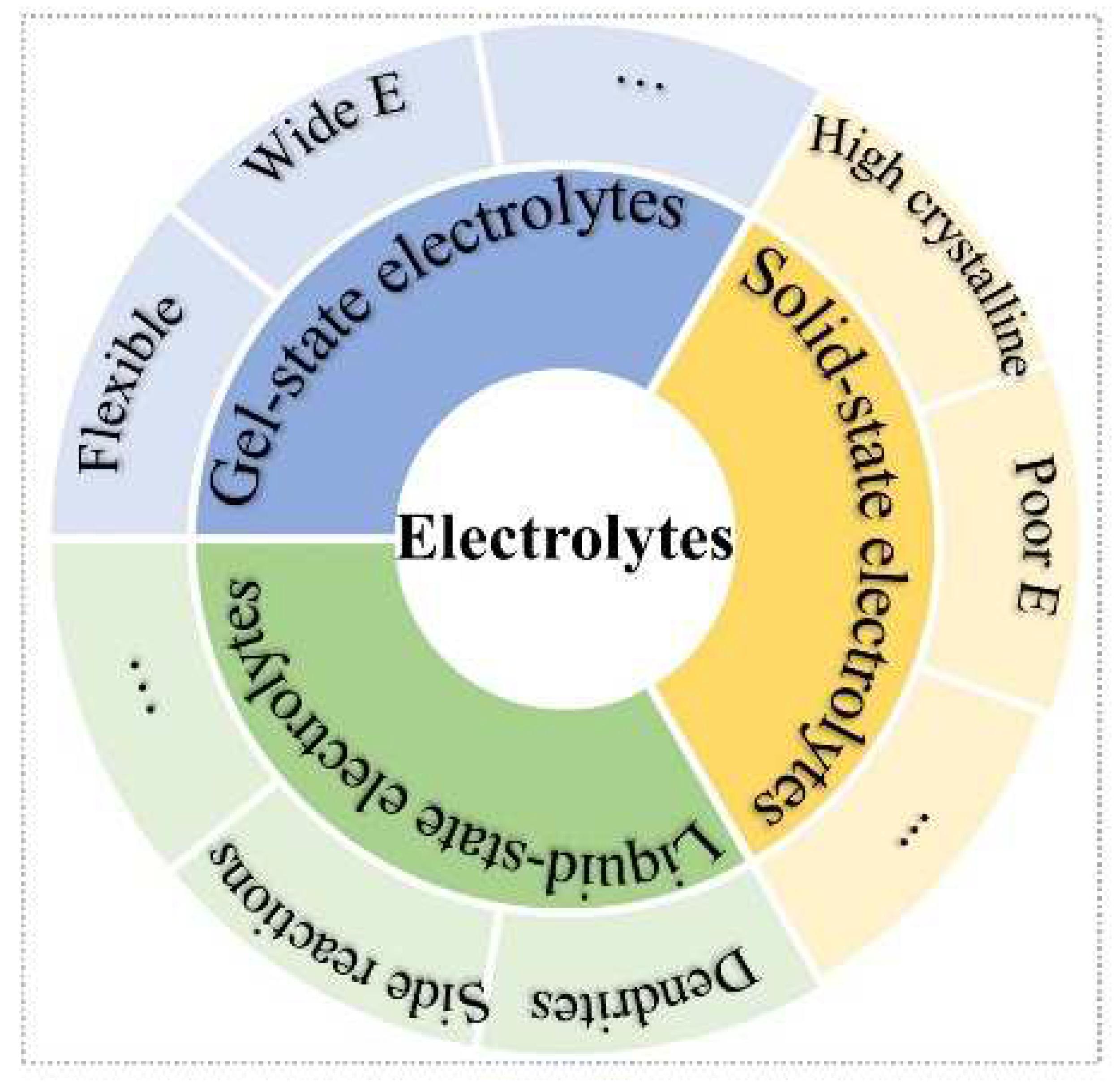
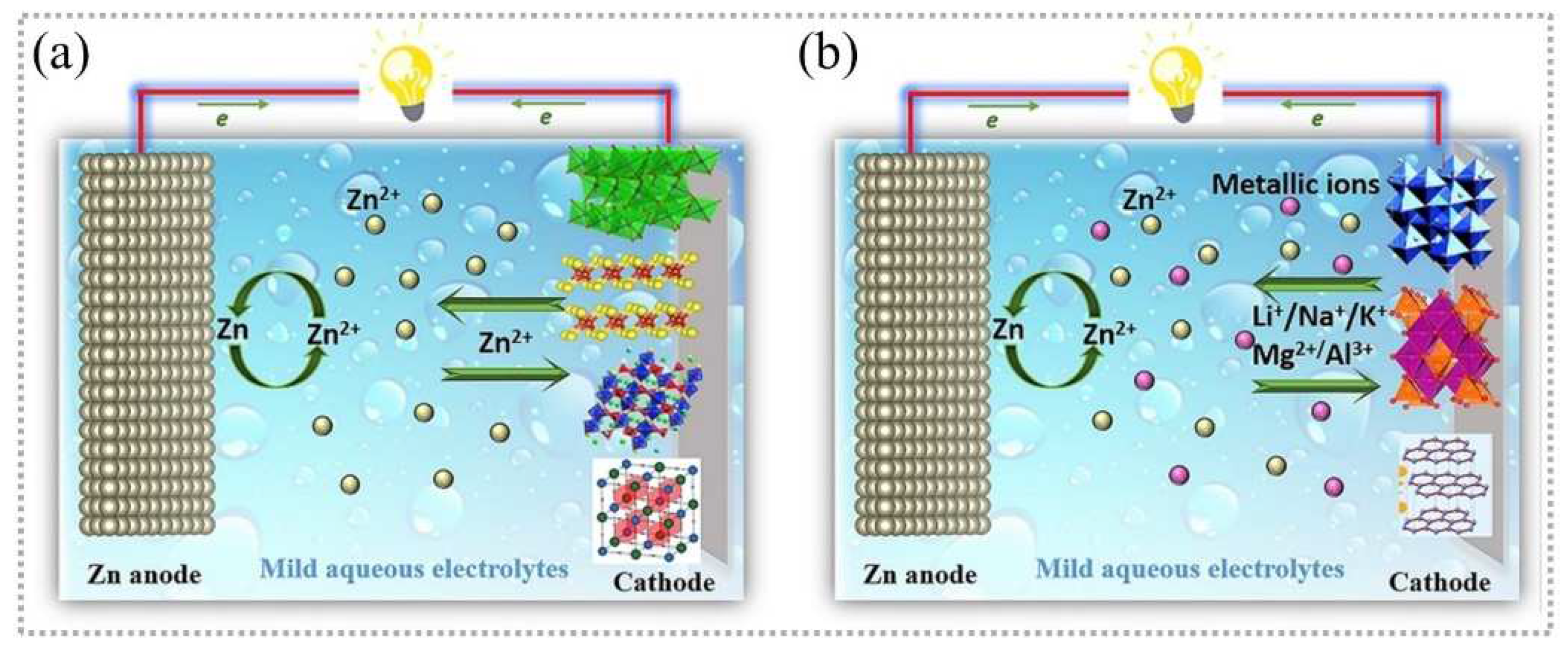
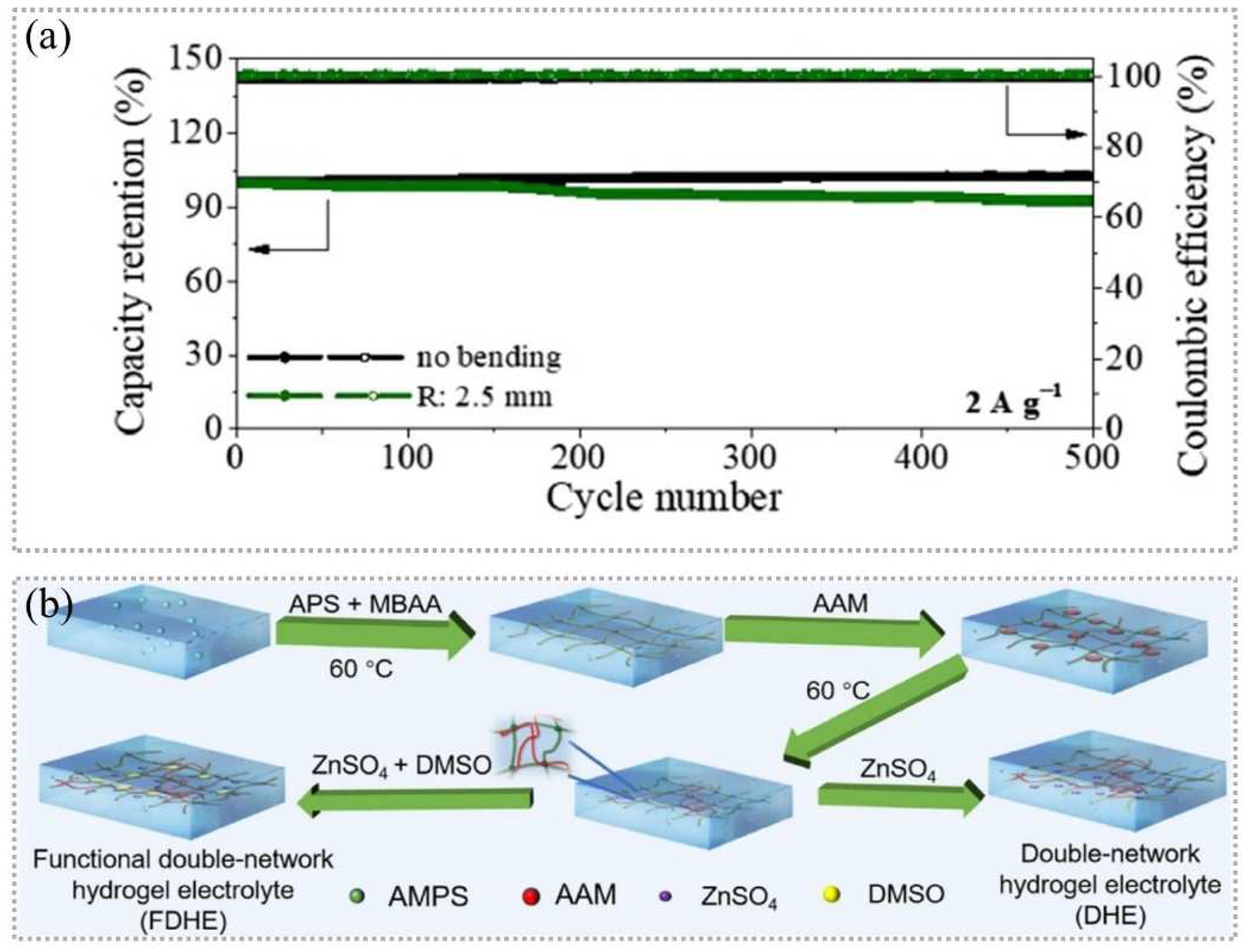
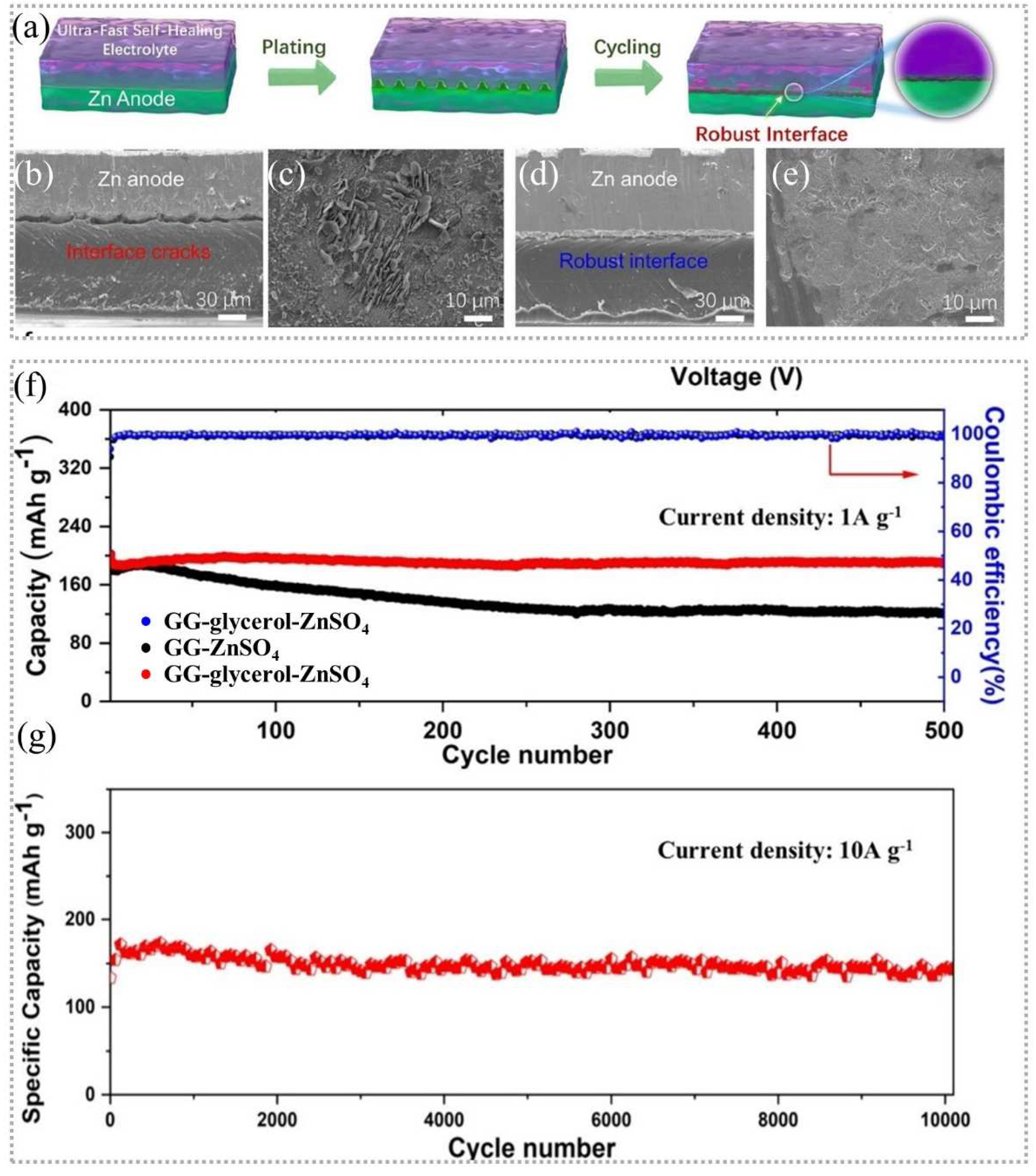
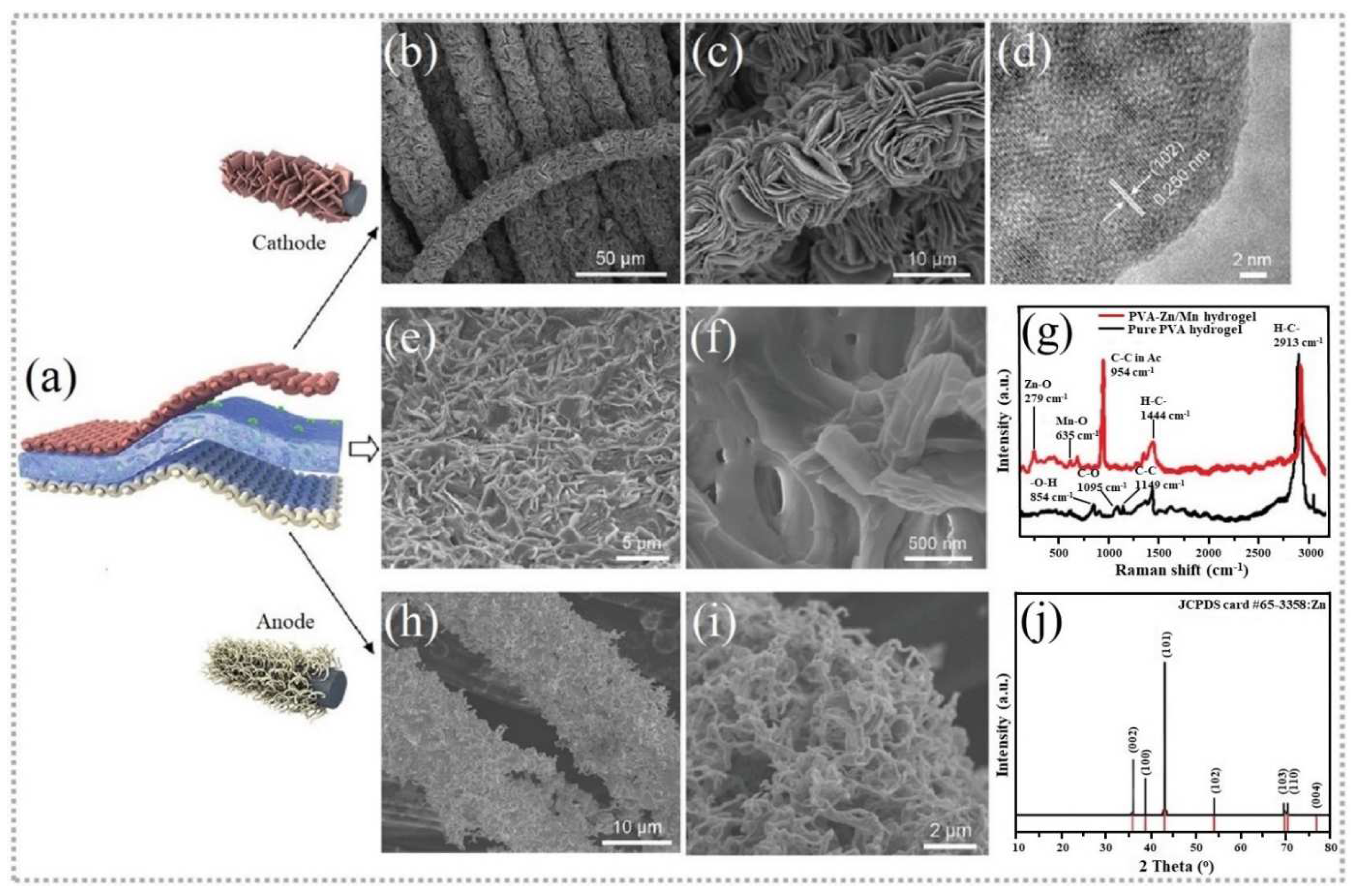



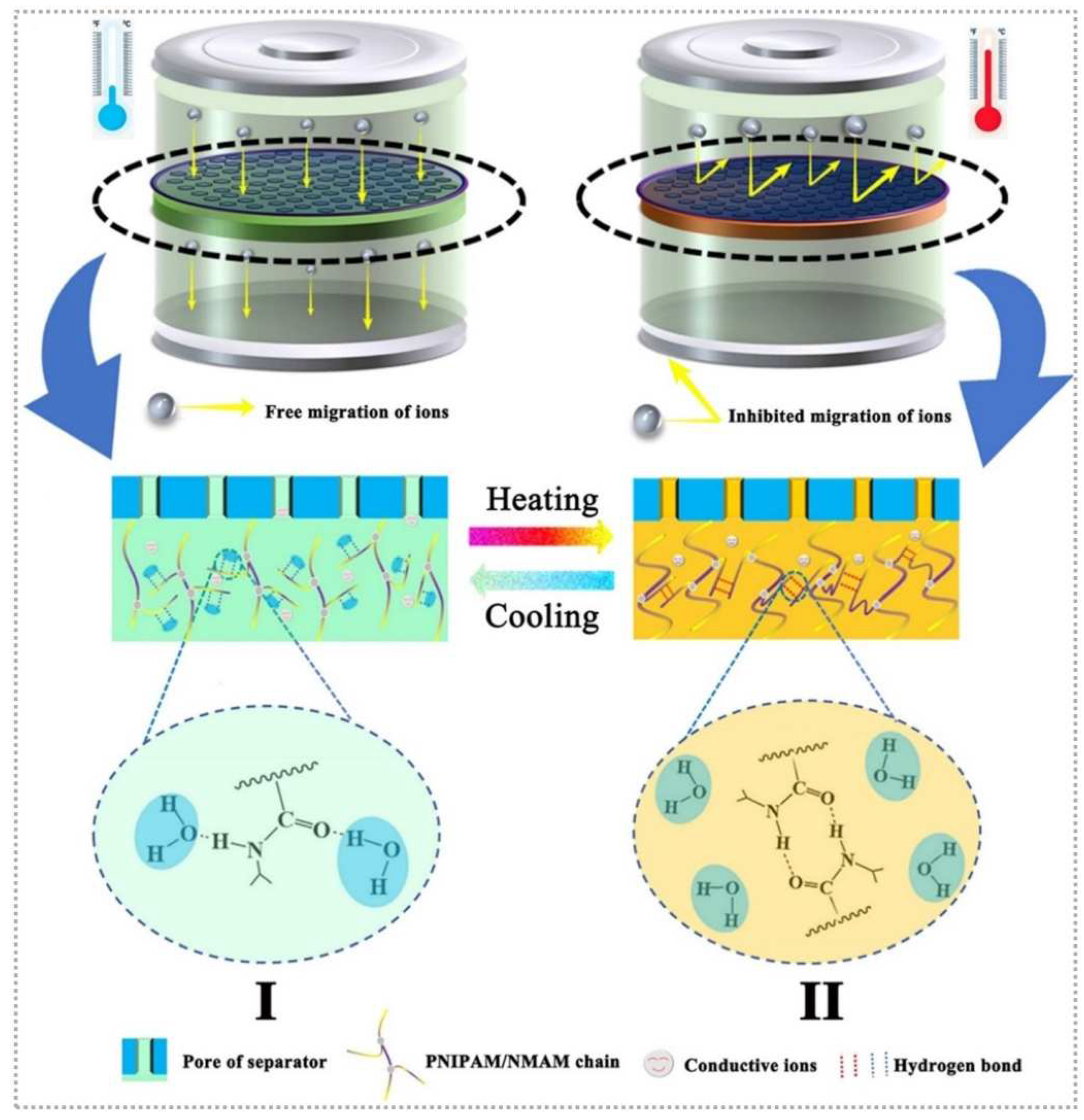
Publisher’s Note: MDPI stays neutral with regard to jurisdictional claims in published maps and institutional affiliations. |
© 2022 by the authors. Licensee MDPI, Basel, Switzerland. This article is an open access article distributed under the terms and conditions of the Creative Commons Attribution (CC BY) license (https://creativecommons.org/licenses/by/4.0/).
Share and Cite
Hu, F.; Li, M.; Gao, G.; Fan, H.; Ma, L. The Gel-State Electrolytes in Zinc-Ion Batteries. Batteries 2022, 8, 214. https://doi.org/10.3390/batteries8110214
Hu F, Li M, Gao G, Fan H, Ma L. The Gel-State Electrolytes in Zinc-Ion Batteries. Batteries. 2022; 8(11):214. https://doi.org/10.3390/batteries8110214
Chicago/Turabian StyleHu, Fulong, Maoyun Li, Guowei Gao, Huiqing Fan, and Longtao Ma. 2022. "The Gel-State Electrolytes in Zinc-Ion Batteries" Batteries 8, no. 11: 214. https://doi.org/10.3390/batteries8110214
APA StyleHu, F., Li, M., Gao, G., Fan, H., & Ma, L. (2022). The Gel-State Electrolytes in Zinc-Ion Batteries. Batteries, 8(11), 214. https://doi.org/10.3390/batteries8110214









